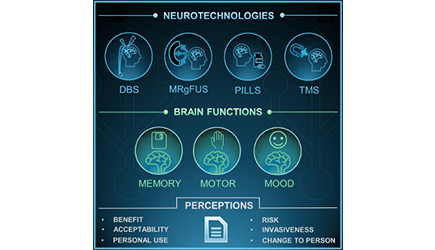Featured Story:
From Pills to Brain Stimulation: Public Views on Modulating Brain Function with Neurotechnologies
October 31, 2025
Rémy Furrer and Amanda Merner share the results of a survey of 1,052 U.S. adults, which found that neurotechnologies targeting motor symptoms were viewed as more acceptable and beneficial than those for mood or memory symptoms. Non-surgical options like transcranial magnetic stimulation were generally preferred over invasive ones such as deep brain stimulation.
Community Stories
November 24, 2025
Chuck Phillips of the Corey lab shares new research on the biophysics of how we hear—providing insight on the molecular mechanisms by which the ion channel protein TMC1, found on hair cells in the inner ear, moves in response to force and works to convert the mechanical energy of sound into electrical signals that the brain can understand.
August 20, 2025
New research reveals that acute and chronic insults both reshape how pain signals are sent to the brain, but through distinct mechanisms. By using long-term calcium imaging in mice, researchers from the Woolf lab tracked the same spinal cord neurons over time and found that acute pain temporarily increases sensitivity, while chronic nerve injury recruits a previously ‘silent’ group of neurons – offering a potential key to understanding chronic pain.
Original article in: Neuron >
August 13, 2025
Bryan Baxter and Dara Manoach share a new study on the brain basis of motor learning. When learning a typing task, epilepsy patients show higher rates of “hippocampal ripples”--an electrical activity pattern in the brain associated with memory formation--during brief rest breaks than during the typing itself. These ‘offline’ ripples predict gains in speed, suggesting that ripples contribute to motor learning during wakeful rest.
Original article in: Nature Communications >
July 17, 2025
Dost Öngür introduces a perspectives piece arising from a meeting he recently organized, bringing together experts in neuroscience, psychiatry, and metabolism to discuss how disruptions in brain energy metabolism may contribute to psychiatric disorders—and what might be done to develop innovative therapeutics.
Original article in: Nature Mental Health >
In the News
December 3, 2025
In the latest episode of the "Harvard Thinking" podscast, host Samantha Laine Perfas talks with Venki Murthy, Margaret O’Connor, and Daniel Schacter about the science of memory — and what we can do to remember better.
December 3, 2025
Exposure to light at night raises cardiovascular disease risk by up to 50 percent over sleeping in the dark, new research from Andrew J.K. Phillips, Sean W. Cain (Flinders University) and colleagues, co-first authors Daniel P. Windred (Flinders University) and Angus C. Burns (Harvard) shows. However, this risk isn’t from lack of sleep, but from disruption of the body’s master biological clock, the circadian rhythm.
Original article in: JAMA Network Open >
December 3, 2025
A vein of Galen malformation (VOGM) is a rare vascular condition involving significantly elevated blood flow to the head and can result in congestive heart failure, pulmonary hypertension, and brain injury if left untreated. New research from Darren Orbach and colleagues demonstrates the viability of a minimally invasive procedure called fetal embolization for managing this condition prenatally.
Original article in: JAMA >
Awards & Honors
December 3, 2025
Round up of awards and honors earned by the HBI community.
November 10, 2025
Round up of awards and honors earned by the HBI community.









